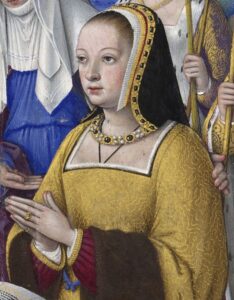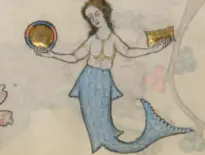
Anne of Brittany
In 1499, King Louis XII of France had his 22-year marriage annulled to marry Anne of Brittany, one of the most sought-after women in Europe. But why did Louis go to such lengths? And what happened to his first wife, who had been loyal for two decades?
This is a story of royal marriages, political scheming, and a forgotten queen who became a saint.
On this day in Tudor history, 8th January 1499, French king Louis XII married the queen dowager, Anne of Brittany, in Nantes.
Louis had had his twenty-two-year marriage annulled so that he could marry Anne, but why and on what grounds?
Well, let me tell you first about Louis’ first marriage, a marriage that he didn’t want. Back in 1464, when Louis was just two, his second cousin, King Louis XI of France, arranged the betrothal of our Louis, who was Duke of Orléans at the time, with the king’s second daughter, Joan or Jeanne, who was just a few days old. Little Joan had been born with some disabilities, likely severe scoliosis of the spine and a club foot. The king believed that Joan would never be able to have children and so he decided to use his infant daughter strategically. He saw the young Louis of Orléans as a threat to the line of succession. Louis was a member of the royal house of Valois so had a claim to the French throne, and not only that, he had a claim to the Milan, a rich duchy. He was going to grow up to be a powerful man.
Louis XI, who has gone down in history as the Spider King, for his scheming, figured that if Louis married Joan and they didn’t have any children, then that branch of the House of Valois would come to an end. And, if the king’s son and heir, Charles, became king following Louis XI’s death, but died without issue, leaving the throne to Louis, Duke of Orléans, Joan would become queen as his consort. Quite a scheme. It was win-win really. Well, for Louis XI. Our Louis didn’t want to marry Joan, but he wasn’t given a choice, and they were married in 1476 when Louis was 14 and Joan was 12. It was not a happy marriage. Louis avoided being in Joan’s company whenever possible, so it’s not surprising that their marriage remained childless.
1n 1483, Joan’s father died, leaving the throne to her thirteen-year-old brother, Charles, who became King Charles VIII with their elder sister Anne acting as regent. In 1491, when Charles became of age, he married the fourteen-year-old Anne, Duchess of Brittany. Anne had just married Emperor Maximilian I by proxy, but Charles was determined to marry her and bind Brittany to France. He lay siege to Rennes, where Anne was, and Anne surrendered to him and agreed to marry him. Charles had to break off his betrothal to Margaret of Austria to do so, but Brittany was worth it.
So much scheming!

Louis XII
Anne was pregnant at least six times during their seven-year marriage, but sadly none of their children survived childhood. Charles died in 1498 after hitting his head on a lintel at the Royal Chateau of Amboise. As he had no children, the throne passed to his nearest male relative, Louis, Duke of Orléans, who was, of course, married to Charles’s sister Joan. Louis became King Louis XII of France.
Scheming was obviously in the House of Valois genes because Louis XII began scheming. Charles’s death left Anne of Brittany a widow and it meant that the duchy of Brittany was no longer tied to the French crown. By the terms of her marriage treaty, Anne was bound to marry Charles’ heir, but obviously that heir was married. Louis wasn’t happy about losing Brittany, so he negotiated with Anne and she agreed to marry him if he could get his present marriage annulled. So, Louis go on with it. He appealed to Pope Alexander VI claiming that his marriage to Joan was not valid as they were closely related and Joan’s father had also been his godfather, he had never consented to the marriage and it had never been consummated because of Joan’s deformities. Joan opposed the annulment, arguing that dispensations had been granted, and she also stated that it had been consummated, providing a witness who stated that the king had said one morning, “I have earned, and well earned a drink for I mounted my wife three or four times during the night.” When Louis then claimed that he hadn’t been able to do the deed because of witchcraft, Joan asked how, in that case, he knew what it was like to try and have sex with her. Despite Joan’s strong case, it suited the pope politically to grant the annulment. It was granted within the year stipulated by Anne and so Anne had to marry Louis.
By the terms of their marriage contract, Anne kept her rights to the duchy of Brittany, although Louis would rule in her name, and it was agreed that the duchy would be inherited by the couple’s second son or daughter. On this day in 1499, Louis and Anne married, and Anne became Queen of France for a second time. Louis was 26 years old and Anne was twenty-two. Anne gave birth to their first child, a daughter, Claude, nine months after their wedding, and went on to experience at least four more pregnancies, but only another daughter daughter, Renée, survived infancy. Anne died in January 1514 and her husband went on to marry Mary Tudor, sister of Henry VIII, in October 1514, but then himself died on 1st January 1515.

Joan of France
But what happened to Joan, Louis’ first wife, who’d been so cruelly set aside after twenty-plus years of marriage? Well, the pious ex-queen, who was granted the duchy of Berry and an annual income of 12,000 crowns, said that she would pray for her husband. She then retired to Bourges, where she founded the Order of the Annunciation of the Blessed Virgin Mary and committed herself to the order, dedicating the rest of her life to God and to helping the poor and sick. She died on 4th February 1505 and was buried in her monastery chapel. Sadly, during the French Wars of Religion, Bourges was sacked by the Huguenots and Joan’s body, which was recorded as being “incorrupted” was burned.
Joan was beatified by Pope Benedict XIV in 1750 and canonised by Pope Pius XII in 1950. She is known as St Joan of France.
If you prefer, you can see this post as a video:



Leave a Reply